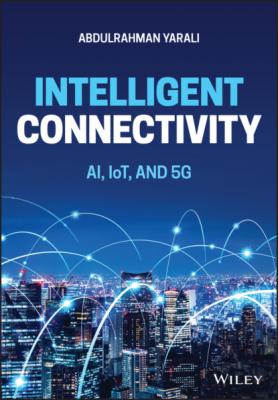ТОП просматриваемых книг сайта:
Intelligent Connectivity. Abdulrahman Yarali
Читать онлайн.Название Intelligent Connectivity
Год выпуска 0
isbn 9781119685210
Автор произведения Abdulrahman Yarali
Жанр Программы
Издательство John Wiley & Sons Limited
27 Prysmian (2017). Debating the connectivity of tomorrow – Stories – Stories | Prysmian Group. https://www.prysmiangroup.com/en/stories/debating‐the‐connectivity‐of‐tomorrow (accessed 22 June 2021).
28 Rademaker, M. (2016). Assessing cyber security 2015. Information & Security: An International Journal 34: 93–104. https://doi.org/10.11610/isij.3407.
29 Ramey, K. (2012). Use of technology in business – To gain competitive advantage – Use of technology. https://www.useoftechnology.com/technology‐business‐competitive‐advantage/ (accessed 22 June 2021).
30 Samuels, M. (2018). Computing the future: What is next for the cloud industry? https://www.raconteur.net/technology/future‐cloud‐computing (accessed 22 June 2021).
31 Tempels, M. (2016). Connectivity Today and Tomorrow [Ebook] 1e. Telenet Business.
32 Tredinnick, L. (2017). Artificial Intelligence and professional roles. Business Information Review 34 (1): 37–41. https://doi.org/10.1177/0266382117692621.
33 UN (2018). Strategy on new technologies. https://www.un.org/en/newtechnologies/images/pdf/SGs‐Strategy‐on‐New‐Technologies.pdf (accessed 22 June 2021).
34 Veletsianos, G. (2018). The defining characteristics of emerging technologies and emerging practices. https://www.veletsianos.com/2016/06/13/defining‐characteristics‐of‐emerging‐technologies‐and‐emerging‐practices/ (accessed 22 June 2021).
35 Whitmire, B. (2014). Increase your competitive advantage using technology. http://www.pinnacleofindiana.com/blog/blog/2014/01/21/increase‐your‐competitive‐advantage‐using‐technology/ (accessed 22 June 2021).
36 Yasar, B. (2019). Intelligent interfaces: Reimagining the way humans, machines, and data interact. https://www2.deloitte.com/content/dam/Deloitte/uk/Documents/technology/deloitte‐uk‐tech‐trends‐2019‐chapter5‐intelligent‐interfaces.pdf (accessed 22 June 2021).
2 Telecommunication Transformation and Intelligent Connectivity
2.1 Introduction
The telecommunication industry is one of many that have gone through important modifications. Several organizations retained their on‐premise telecommunication platforms. However, there has been an incessant adoption of cloud‐hosted telephony resolves (Ismail 2019). Worldwide telecommunications indicate that the industry is susceptible to modifications in technology cycles, client requirements, and competition's actions. These various modifications are experienced in many forms. Today in society, technology has such an important role in people and their everyday lives. The advancement of technology has always been a changing feat, and the changing of technology is crucial to maintain more advanced lives. Technology is used for personal use; it is now making its way into everyday life. It is also gaining hold of the industrial manufacturing and health care sectors of society. When we think of technology, a lot of people think of computers and cell phones. These are great things to think of, but now there are a few new advancements that are drawing in consumers and businesses worldwide. These are Internet of Things (IoT) devices and fifth generation (5G) networks that can support these IoT devices. These are two new concepts to the technology world. Today, however, it seems they are more than just a concept. These technologies are already being used and utilized for personal use and the industrial manufacturing and health care sectors.
There have been many advantages in technology in the last decade breakthroughs. Smartphones, the IoTs, and the introduction to Artificial Intelligence (AI) and its usage within different aspects of our lives have paved the digital era's road to pervasive connectivity. With such great technological changes and their adaptation in different aspects of life, enhancement and increased productivity have been the result. However, humanity did not stop there as we aimed for higher ground with technology, which resulted in more intelligent connectivity. This included the fusion of different technologies, which fostered a path towards much more advanced outcomes. To explore and realize the full potential of the IoT future to capture massive data from the pervasive connectivity of devices, will require investment and coexistence of new technologies. Fourth generation (4G) technology has been around for almost a decade since it was first introduced commercially in December 2009 (Telia Company 2019). With greater advancements, significant outcomes and improvements are being made. This includes the fusion of 5G, IoT, and AI. It focuses on fostering a future that is much more intelligent and will result in a better life where everyone is connected in a much more advanced and intelligent way. AI, ML (Machine Learning), Blockchain, and IoT are the top technologies currently used by businesses to increase efficiency, productivity, and increase their competitiveness in this fast‐paced digital era transformation. Figure 2.1 shows companies' investment details on the implementation of these new technologies (Vinugayathri n.d.).
It has been found that IoT now has almost 25 billion devices being connected, with a prediction of 80 billion connected devices by 2025. AI has led to the computer IQ level of 10 000+ to enhance performance and efficiency, and 5G interoperable, flexible, high‐speed, reliable, high capacity with almost zero delay network connection will reach 1.2 billion by 2025 worldwide (Sterlite Tech 2019).
These technologies will form the basis for what is being colloquially defined as Intelligent Connectivity. Through these technologies, it will become possible to transition to a digitally driven, sustainable world. Figure 2.2 depicts the detail of AI, IoT, and 5G Intelligent Connectivity (Sterlite Tech 2019).
The future of technology relies on Intelligent Connectivity. High‐speed 5G and sixth generation (6G) networks with IoT technology and AI make up Intelligent Connectivity. A fact that is gradually becoming a reality as IoT technology is improved upon, 5G becomes the new communication standard for mobile devices and AI becomes increasingly commonplace in businesses. The applications for business, agriculture, education, transportation, and public safety is already showing promise as a concept. As it becomes commonplace, it could lead to a revolution that is as big – if not bigger – than the concept of personal computers.
At its most basic, AI refers to machines that can compute to extend their functionalities to such an extent that they can “learn,” displaying the presence of “intelligence” among such artificial constructs (Katsaros and Dianati 2017). This fundamental difference is significant to consider as it should contrast with human intelligence at large. Current AI literature shows the importance of creating “intelligent agents” as a practical manifestation of the technology wherein the specific machines could perceive everything is happening in the environment and successfully capitalizing upon it to reach their own goals. Moreover, a higher consideration is that, apart from learning, the machines should become able to “mimic” human cognition in the most accurate way

